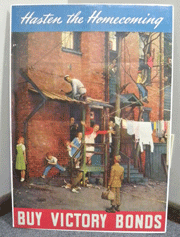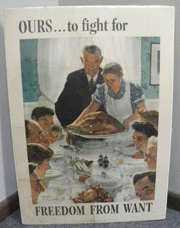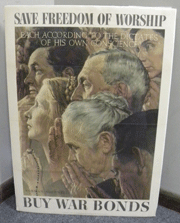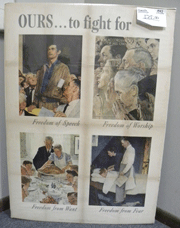|
Collecting Posters And Propaganda From WW I and II
By Debra Tobin
Posted 9/2010
Having a very long history; some say posters date as far back as several hundreds of years BC, although there are no illustrations or representations of posters from that period. Evidence shows that beginning in the 16th century posters were being used to advertise everything from plays to new products opening the world’s eyes to a new revelation in advertising. As the years advanced, so did the quality of posters and the manner in which posters were perceived.
While some argue that early movie posters best represent the use of the poster during the early 20th Century, it was World War I and II that gave new life and spirit in the use of graphic arts to develop some of the most famous and sought-after posters in the world today. Some of the most eventful posters of all times include the propaganda posters of World War I and World War II. It didn’t take long for the government to figure out that valuable and important messages could be portrayed on posters that would be seen around the world.
Throughout history victory or war posters were often used by the government to raise the awareness of the American society and stimulate patriotism, productivity and sacrifice. Messages on posters not only encouraged people to enlist in the armed services, but often prompted Americans to maintain secrecy, plant victory gardens, conserve resources and persuaded women to enter the workforce.
Today, World War I posters are very much in demand; especially those issued by the U.S. Food Administration. Other posters supporting issues such as raising money for Liberty Loans, Liberty Bonds, War Stamps and the Red Cross were very prevalent during war times and are among some of the most sought-after posters in the antique market today. According to collectors, the Red Cross posters from this era are extremely desirable.
It was during the war that several of the most celebrated and distinguished artists gained notability. James Montgomery Flagg, Howard Chandler Christy and Harrison Fisher are at the top of the list of artists when it comes to collecting posters from the World War I Era. However, it was during World War II, that one of the most prominent artists of all time captured the hearts and attention of all Americans with his paintings of the “four essential human freedoms.”
Inspired by President Franklin Roosevelt’s message to Congress in 1941, Norman Rockwell, famed artist and creator of 321 Saturday Evening Post magazine covers, sought to create paintings for the government of the “Four Freedoms” as presented by Roosevelt, but the government declined his offer. The paintings depicting Freedom of Worship, Freedom of Speech, Freedom from Want, and Freedom from Fear were commissioned by The Saturday Evening Post. They became so renowned and triumphant that eventually they were nationally exhibited to sell war bonds, helping to raise approximately $139.9 million for the war effort.
From 1916 through 1963, Norman Rockwell and The Saturday Evening Post became a household fixture as well as a weekly visitor to many American homes. Gracing the covers of not only The Saturday Evening Post but other magazines as well, including Look, Rockwell made history and became an American icon. His desire and love of his profession coupled with his love of people and portraying them in everyday life made his posters some of the most collectible in the world.
Jeff Burnett has been collecting posters from World Wars I and II for more than 30 years and dealing in them for over 15 years. According to him, the condition of the poster is vital to the buyer as well as the seller. Rips and tears must be mended using only archival tape, and the posters should be mounted on acid-free foam core and framed by someone who is familiar with archival procedures.
“It always amazes me that so many of these posters have even survived,” he commented. “These works of art are treasures of history and must be treated as such,” he said.
Burnett noted that posters from WW I were usually rolled up when sent to various distribution points, while WW II posters were almost always folded and shipped in a brown envelope.
“The rule of thumb is that you must see the folds in World War II posters for them to be real and recognize that the folds do not come out,” Burnett explained. “Posters from the World Wars used to be readily available and could be found at very low prices, but the present market is very strong as people have come to appreciate the history and artwork of days gone by,” he continued.
Burnett said reproductions do abound but normally are not the original size. “Buyers beware and only buy from a dealer experienced in quality paper items,” he stated.
According to Burnett, the price of posters is determined by the artist, scene, size and condition. Some can be found for as little as $50 while others can go as high as $10,000 or more.
Burnett can be found each month at Scott Antique Markets in Atlanta and at the Ohio market November through March. His collection not only includes the works of art of Norman Rockwell’s World War I and II posters, but many other famous artists as well including James Montgomery Flagg.
______________________
For more information on Scott Antique Markets, call 740-569-4912 or visit www.scottantiquemarket.com.
|

1945 Poster by Norman Rockwell, “Hasten the Homecoming, Buy Victory Bonds,” sold for $625 at Scott Antique Markets in Ohio.

One of the most popular of the Four Freedoms posters, this Thanksgiving scene completed in 1943 by Norman Rockwell depicts “Freedom from Want.”

One of the Four Freedoms posters designed by Norman Rockwell, “Save Freedom of Worship” was completed in 1943 and sold for $325 at the Ohio Scott Antique Markets.

This poster shows all four freedoms: Freedom of Speech; Freedom of Worship; Freedom from Want; and Freedom from Fear.
|